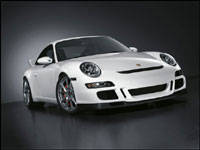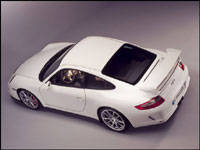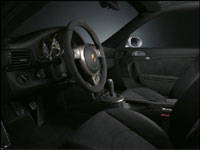Phenomenal New GT3 Breaks Cover in GenevaOn February 13th, 2006, Porsche announced one of its
 |
| Is the GT3 Porsche's finest 911 to date? (Photo: Porsche Cars Canada) |
most long-awaited models, the sixth generation 911 Turbo. Indeed, this is an important car for Porsche, as it's the model that has to live up to the legend of the world's first turbocharged production car, and one of the best all-round sports cars made to date, the previous-generation 911 Turbo.
The new (997) Turbo builds on previous models by advancing the all-wheel drive system and tipping the world of turbocharging on its side once again by implementing the world's first variable geometry turbo on a gasoline-powered car. The 911 Turbo is so vital to the Porsche brand, that it's been titled the 'masterwerk'. But let's not forget that there's still another vehicle that stands above it in the 911 range, the 911 GT3.
Though
 |
| Defies physics, and now, the GT3 defies aerodynamics with an ultra-low drag rating. (Photo: Porsche Cars Canada) |
there aren't any doubts that the Turbo is a very important car from technological, sales and historical standpoints, the GT3 is the car that was Porsche's outright star at Geneva. The GT3 represents Porsche's racing heritage filtered down for road-legal use, and they've taken every aspect of this conversion as seriously and as passionately as possible.
Proof? Your eyes should easily catch the difference between this and standard 911s. It features new front bumpers for better airflow in, and new rear bumpers for better airflow out the back (where the engine is), and in between nose and tail, plates cover the mechanical bits under the car to improve airflow there too. The GT3's tail spoiler has also grown larger in size, and there's an additional vent that has snuck its way in front of the nose-mounted trunk. All of that and the car manages to slip through the air with a drag coefficient rating of 0.29 cd, better than most modern cars with skinny tires, narrow bodies and no gigantic drag-increasing spoiler.
If it weren't for its race car looks, how would a person find out
 |
| You can't see it, but the 3.6 litre H-6 engine is one of the finest powerplants on earth. (Photo: Porsche Cars Canada) |
just what a thoroughbred this car is? A glimpse of the engine ought to help. The 3.6-litre, naturally-aspirated horizontally-opposed six-cylinder is an evolution of the very engine that powered Porsche's Le Mans-winning GT1 back in 1998. Yes, that car! Power is up to 415-horsepower (an amazing 115 hp/L), a big step forwards from the old car's 380-hp, while torque has been boosted to 298 lb-ft. Also increased is the car's stratospheric redline, which is 200 rpm higher at 8,400. Enabling these improvements are a host of finely-tuned changes to the engine's airflow system that include a better-optimized air intake, 6 mm larger throttle valve, and new cylinder heads that have low drag. This is aside from titanium connecting rods and aluminum heads, which make the whole unit lighter. Oh, and we can't forget the GT3's forged exhaust system, which aids in reducing the engine's overall backpressure.
The old GT3 was about being able to drive your track-day Porsche to
 |
| Focus remains on driver with proper race seats, optional harnesses, roll-cage and fire extinguisher. (Photo: Porsche Cars Canada) |
and from the circuit, but it was about as luxurious cell-block 'C'. In some respects, the new GT3 continues in this tradition, without rear seats, and with less sound deadening material than the standard car, and the car can be fitted with a roll cage, racing harnesses and fire extinguisher for no extra cost. What you do get are some LED lights that tell you when to shift up, and a few electronic measures to help you shave a few seconds off the lap times recorded by the dash-mounted stopwatch. The new GT3 comes with the PASM active suspension system that allows the driver to stiffen the suspension from hard (comparable to the previous GT3) to even harder, for improved performance on the track. It also features a mechanical limited-slip differential and the same traction control system that the Carrera GT supercar used. Of course, this being a proper enthusiast's tool, all electronics can be switched off.






